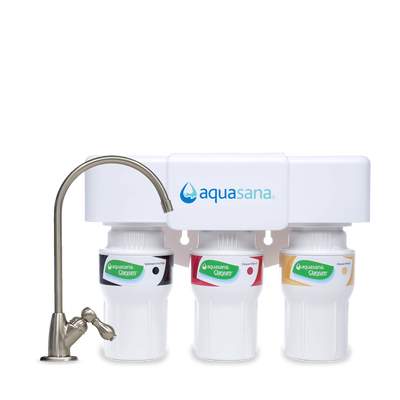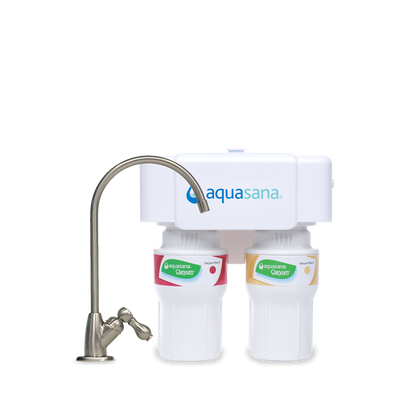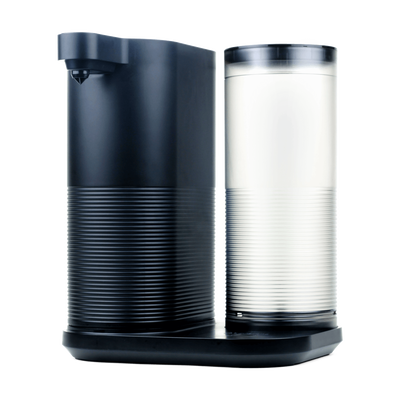One of Aquasana’s taglines is “bottle your own.” Bottling your own water keeps disposable plastic water bottles out of landfills and reduces the extensive carbon footprint from their distribution. Our drinking water filtration systems can replace up to 4,500 plastic bottles per filter set. For example, our Clean Water Machine is equal to 2,400 disposable plastic water bottles.
To bottle your own water, first you need a water filter, but you also need a bottle. The water bottle options are staggering. There are entire aisles of different bottles: glass, stainless steel, plastic, insulated, with flavor chambers, disposable, collapsible. This list is endless and it can leave consumers wondering which is the best water bottle?
To help you decide, we’ve compiled everything you need to know about the most popular reusable water bottle options, along with information on why you shouldn’t use disposable plastic bottles.
Glass Water bottles
Glass is the boss in the reusable water bottle category. It is the safest and best way to store both food and liquids for several reasons. Water in glass bottles isn’t affected by any flavor from the container, giving it a “purity of taste” benefit when compared to plastic bottles and other options. Glass also offers peace of mind. Many plastics, and some metal, vessels contain bisphenol A (BPA), a chemical the Food and Drug Administration (FDA) began warning about in 2010 due to its correlation with cancer. Glass is the safest water bottle type because it’s chemical-free, made from natural materials, and dishwasher safe. When buying a glass bottle, there are a few things to look for:
- Has it been tested for lead and cadmium content? Make sure it has been tested and that neither are present – it’s that simple.
- There are different types of glass. Borosilicate is the top of the line – think Pyrex®. This stuff can withstand high and low temps without shattering, and is lighter and less prone to break. Soda-lime glass, which is the glass primarily used for windows, or traditional glass are also great options that are less expensive.
While there are countless reasons to avoid disposable plastic bottles (that we’ll touch on later), a lot of people opt for a reusable plastic bottle as their daily go-to. These bottles are appealing because they’re often inexpensive and lightweight. However, there are some things you need to be aware of when purchasing. Most notably, check to make sure the bottle is BPA-free, as many plastic bottles contain the harmful chemical. Additionally, you should be careful when using a plastic bottle, as it’s more likely to warp compared to other types which is another reason we suggest a glass or metal option.Stainless steel bottles
Stainless steel bottlesare made from “culinary-grade” stainless steel. They come in a wide variety of sizes and different colors. There are no known safety concerns associated with using stainless steel, assuming it is indeed stainless and lead-free. Compared to water in glass bottles, some people think stainless steel bottles make your water have a metallic taste and some can heat up in summer temperatures.
Aluminum water bottles
Aluminum bottles look like stainless steel, but are, in fact, very different. Aluminum is reactive with acidic liquids. So, aluminum bottles have to be lined with an enamel or epoxy that can wear away over time. BPA is often the main ingredient used in epoxy, meaning aluminum water bottles may not be safe to use long-term. Like stainless steel, aluminum will also dent if you drop it, and it is not dishwasher safe. This would be the last option to resort to before purchasing plastic disposable bottled water.

disposable Plastic water bottles
Inexpensive disposable water bottles are made of plastic #1 or PET. PET, or polyethylene terephthalate, is the lightweight, clear plastic that is widely used for packaging foods and beverages. Some people try to wash these bottles out and reuse them, but bottles made out of plastic #1 are not reusable. Bottles made of plastic #1 are not durable enough to withstand use, cleaning, and reuse without losing their integrity. Cracks can form in these bottles and bacteria can easily grow. This is especially true if the bottle is stored in a warm area like a garage or a car.

Even with so many downsides to disposable plastic bottles, that doesn’t stop the production lines from making more. In fact, more than 60 million plastic bottles are produced, transported, and disposed of EVERY DAY in the U.S. alone. Not only that, but for such a large industry, it’s fairly unregulated by the FDA, and there are currently no government standards that require bottled water to be any better, purer, or safer than tap water.
Which water bottle is best for you?
Now that you know the benefits of bottling your own water and what to look for when purchasing a water bottle – pick one that’s best for you! Glass is the safest water bottle type and offers the purity of taste, but stainless steel offers insulation benefits that keep your beverages hot or cold. Don’t forget about a filter! The filter you use is just as important as the bottle you drink from, so make sure you’re using a filter that’s effectively removing contaminants at home. Aquasana offers a wide selection of whole house, under sink, and countertop water filters that can transform your tap water into healthy, great-tasting water that you can bottle to stay hydrated wherever you go.



